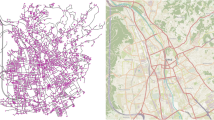Abstract
A metropolitan area is an area with dynamic demands and is one of the main indicators of economic growth of nation. It involves the complexity of efficient analysis and prediction of patterns of growth or decline of traffic volume and patterns of resource utilization with respect to time and place. To solve these complexities, we propose agent-based commuters’ traffic pattern and prediction analysis model in a metropolitan area. The proposed system model is capable of analyzing and predicting the patterns of commuters’ traffic flow volume and resource utilization in each zone and region, using the population density, availability of resources, type of place, time period, and commuters’ and vehicles’ arrival rates. The proposed model provides qualitative form of traffic; increases the probability of measure of unpredictable information; and aids in emergency traffic planning and route-finding services. The result shows the effectiveness of the model at different time periods in a day for forecasting of the resource utilization and changes in traffic volumes in zones and regions in the metropolitan area.
















Similar content being viewed by others
References
Bickel, P.J., Chen, C., Kwon, J., Rice, J., Van Zwet, E., Varaiya, P.: Measuring traffic. Stat. Sci. 22, 581–597 (2007)
Stathopoulos, A., Karlaftis, M.G.: A multivariate state space approach for urban traffic flow modeling and prediction. Transp. Res. Part C Emerg. Technol. 11(2), 121–135 (2003). Elsevier
Stathopoulos, A., Karlaftis, M.G.: Modeling duration of urban traffic congestion. J. Transp. Eng. 128(6), 587–590 (2002)
Vlahogianni, E.I., Karlaftis, M.G., Golias, J.C.: Optimized and meta-optimized neural networks for short-term traffic flow prediction: a genetic approach. Transp. Res. Part C Emerg. Technol. 13(3), 211–234 (2005). Elsevier
Klügl, F., Bazzan, A., Ossowski, S. (eds.): Applications of agent technology in traffic and transportation. Springer Science and Business Media, Berlin (2006)
Herring, R., et al.: Using mobile phones to forecast arterial traffic through statistical learning. In: 89th Transportation Research Board Annual Meeting, Washington, DC (2010)
Ghosh, B., Basu, B., O’Mahony, M.: Multivariate short-term traffic flow forecasting using time-series analysis. IEEE Trans. Intell. Transp. Syst. 10(2), 246–254 (2009)
Vlahogianni, E., Karlaftis, M.G., Golias, J.C., Kourbelis, N.D.: Pattern-based short-term urban traffic predictor. In: Intelligent Transportation Systems Conference, pp. 389–393. IEEE (2006)
Washington, S.P., Karlaftis, M.G., Mannering, F.L.: Statistical and econometric methods for transportation data analysis. CRC Press, Boca Raton (2010)
Weijermars, W.A.M.: Analysis of urban traffic patterns using clustering. University of Twente (2007)
Lippi, M., Bertini, M., Frasconi, P.: Short-term traffic flow forecasting: an experimental comparison of time-series analysis and supervised learning. IEEE Trans. Intell. Transp. Syst. 14(2), 871–882 (2013)
Castro-Neto, M., et al.: Online-SVR for short-term traffic flow prediction under typical and atypical traffic conditions. Expert Syst. Appl. 36(3), 6164–6173 (2009)
Clark, S.: Traffic prediction using multivariate nonparametric regression. J. Transp. Eng. 129(2), 161–168 (2003)
Xiaoyu, H., Yisheng, W., Siyu, H.: Short-term traffic flow forecasting based on two-tier k-nearest neighbor algorithm. Proc. Soc. Behav. Sci. 96, 2529–2536 (2013)
Quek, C., Pasquier, M., Lim, B.B.S.: POP-TRAFFIC: a novel fuzzy neural approach to road traffic analysis and prediction. IEEE Trans. Intell. Transp. Syst. 7(2), 133–146 (2006)
Kim, Y.-J., Hong, J.-S.: Urban traffic flow prediction system using a multifactor pattern recognition model. IEEE Trans. Intell. Transp. Syst. 16(5), 2744–2755 (2015)
Min, W., Wynter, L.: Real-time road traffic prediction with spatio-temporal correlations. Transp. Res. Part C Emerg. Technol. 19(4), 606–616 (2011)
Ayeni, B.: Mathematical modelling of urban systems in Nigeria. GeoJournal 2(5), 393–402 (1978)
Zhang, X., Chang, G.-L.: A transit-based evacuation model for metropolitan areas. J. Public Transp. 17(3), 9 (2014)
Jere, S., et al.: Extracting commuting patterns in railway networks through matrix decompositions. In: 13th IEEE International Conference on Control Automation Robotics and Vision (ICARCV) (2014)
He, X., Peeta, S.: A marginal utility day-to-day traffic evolution model based on one-step strategic thinking. Transp. Res. Part B Methodol. 84, 237–255 (2016)
Nantes, A., Ngoduy, D., Bhaskar, A., Miska, M., Chung, E.: Real-time traffic state estimation in urban corridors from heterogeneous data. Transp. Res. Part C Emerg. Technol. 66, 99–118 (2016)
Chen, B., Cheng, H.H.: A review of the applications of agent technology in traffic and transportation systems. IEEE Trans. Intell. Transp. Syst. 11(2), 485–497 (2010)
Satoh, I.: Mobile agents. In: Handbook of ambient intelligence and smart environments, pp. 771–791. Springer, US (2010)
Real time traffic flow data. California Department of Transportation (2016). http://pems.dot.ca.gov/. Accessed Jan 2016
Author information
Authors and Affiliations
Corresponding author
Rights and permissions
About this article
Cite this article
Chavhan, S., Venkataram, P. Commuters’ traffic pattern and prediction analysis in a metropolitan area. J Veh Routing Algorithms 1, 33–46 (2018). https://doi.org/10.1007/s41604-017-0004-z
Received:
Accepted:
Published:
Issue Date:
DOI: https://doi.org/10.1007/s41604-017-0004-z




